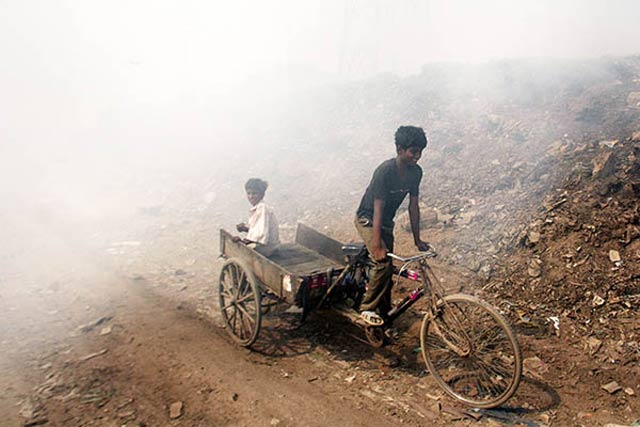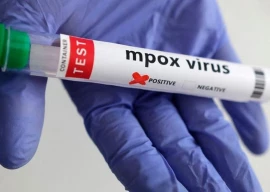
As usual there is again a smog attack in Punjab, especially in and around Lahore, Faisalabad and Gujranwala regions.
The problem is so intense that there is a proposal for calling every Wednesday off for the coming few months.
Smog causes a variety of respiratory, eyes and skin diseases, making life miserable for the affected
and their families.
Smog is caused by a combination of smoke (air pollution) and fog. Air pollution particles ride on fog water and cause double jeopardy. We will discuss in this space the causes and possible solutions.
Is there an immediate solution? Let us first discuss it. There is a solution which has been introduced in China where most cities suffer from a similar problem.
The same solution has been tried in countries of Southeast Asia and Delhi in India. This is water sprinkling but not in a random and unorganised manner.
Water droplets have to be formed and sprinkled from a height of 50 metres. Fire fighting vehicles can be used for
this purpose.
Experts’ assistance may be procured from China. Some accessories may be brought along by the experts themselves.
Admittedly, the solution works and does not work as well depending on the sprinkling techniques used, weather conditions, etc.
Pollution comes down in less than an hour as the water droplets absorbing pollutant particles come down.
Also, there is water consumption issue, which although can be recycled. There is no harm trying this immediate solution.
At least the most affected areas can be selected for action. Air pollution is caused by industries, construction activity, transport vehicles, waste burning, etc.
Transport is considered to be the largest source of air pollution, although in Lahore region, industrial pollution is no less.
Transport control actions like holidays and timings can reduce some air pollution. Fuel quality is another solution.
Fortunately, since 2018, a law has been made to import only low sulphur petrol and diesel.
However, the problem is that local refineries cannot produce low sulphur petrol and diesel.
Until these refineries are upgraded, for which project and policy actions are underway, high sulphur fuel will continue to be used in vehicles.
A possible solution is to ban locally produced high sulphur petrol and diesel in pollution-sensitive areas of central Punjab. It should not be difficult.
Rescheduling of fuel deliveries and some commercial adjustments should be possible.
If nothing else, winter months can be tried for this. In Delhi, there used to be a similar problem and perhaps partly continues to be there. The Supreme Court of India banned use of diesel buses and ordered their conversion into CNG.
They also started a major initiative of producing bio-CNG, which killed two birds with one stone – pollution reduction and increasing energy supplies.
Bio-CNG causes much less pollution than petrol and diesel. Electric vehicles (EVs) are the ultimate solution to the transport sector pollution; easier said than done.
Many countries have started introducing EVs, especially buses. EVs are expensive, although their costs are coming down and cheaper versions coming out for low-income groups.
EV policy of Pakistan targets 30% on-road vehicles to be EVs. CDA Islamabad has taken a bold and progressive step of introducing 30 EV buses.
Lahore can do it as well including the conversion of BRT buses to EVs. Instead of introducing expensive new EVs, priority may be given for the conversion of fuel vehicles to EVs.
For buses, it is a very cost-effective approach. Diesel buses can be converted at one-third of the cost of a new EV. In Pakistan, this knowhow can be developed easily. Buses are assembled here.
Also, 40% of vehicle pollution is from motorcycles. New and converted EV bikes can also help reduce air pollution.
Lahore and Faisalabad regions are major industrial centres. Air emission control devices are seldom installed by even large in-dustries, except for cement and fertiliser ones.
Due to the lack of supply and expensive gas, small industries burn all kinds of waste and dirty fuels, causing pollution. It is difficult to order closure of the small industry.
However, it should be definitely possible to organise industrial site areas at more distant locations. Also, extension services do help.
A new technology has been introduced for less pollution in Bhatta industry. Similarly, other environmental initiatives may be launched with the assistance of international bodies.
Again biogas may be an alternative solution for substituting cheaper dirty fuels. Waste burning, especially agricultural waste burning, is a major issue in the region including India. Rice is grown in the region whose quick stubble removal has been a perpetual problem.
Usually, rice stubble is burnt in open air, causing pollution. Reportedly, some remedial action has been taken but the problem continues. A permanent solution is installing bio-gas plants in these areas for safe disposal of rice stubble and bio-gas production.
In fact, bio-CNG may be a better option, which may provide fuel to tractors. Also, large farmers can install bio-CNG production and even filling plants on or near their land, avoiding injection into the gas grid.
Biogas/ bio-CNG has many other advantages like producing fertilisers as a byproduct and CO2 as a cold chain item – both are required for boosting agriculture. Municipal solid waste (MSW) burning is a usual practice in most parts of Pakistan.
Food streets and vegetable markets are a special source of MSW. In Pakistan, about 50% of MSW is green waste consisting of vegetables, fruit cuttings, etc coming out of houses and commercial centres.
Some 25% is recyclable inorganic waste like paper, glass, plastics, etc.
The green content of MSW can be used in producing biogas and only 10-20% of waste may remain to be land-filled.
Rural household cooking is also a source of both indoor and outdoor pollution. Biomass of various kinds is burnt in inefficient make-do stoves consisting of three bricks loosely put together.
This not only causes excessive pollution but wastes biomass fuel as well. Indoor pollution causes various diseases in women and children.
New gas stoves burning biomass pallets have been developed, which do not cause excessive pollution and burn fuel efficiently.
These stoves cost Rs2,500-5,000 in retail markets. Awareness campaigns, cheaper credit and subsidies may be able to popularise these environmentally beneficent stoves. Gas companies may be tasked to take part
in such schemes.
There is a lot of pollution coming out of construction sector. Often open uncovered trucks are used for material transportation. Site activities also raise a lot of dust. Facade covering and on-site water sprinkling can reduce the dust.
Even road building activities under government projects cause unnecessary pollution.
IFI-supported contracts provide for pollution control activities but local stakeholders do not pay heed to it.
Greenery blocks, wherever possible, may be of help and general water sprinkling on sandy areas around urban settlements can cause reduction in air pollution.
THE WRITER IS FORMER MEMBER ENERGY, PLANNING COMMISSION AND AUTHOR OF SEVERAL BOOKS ON ENERGY SECTOR
























COMMENTS
Comments are moderated and generally will be posted if they are on-topic and not abusive.
For more information, please see our Comments FAQ